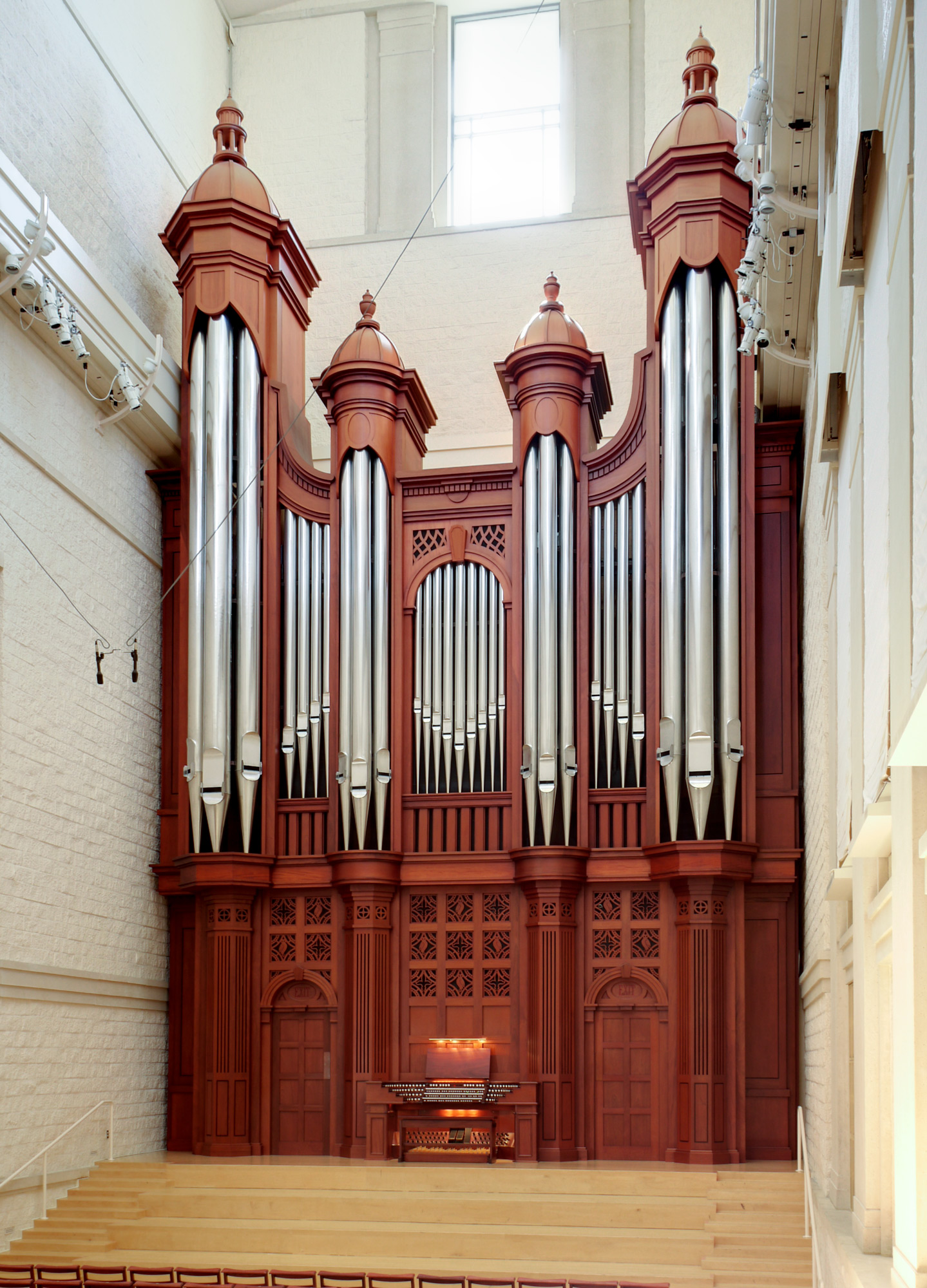
- phone: 978.283.1909
- email: cbfisk@cbfisk.com
Opus 109
Shepherd School of Music, Rice University
Houston, TX
Ranks: 84Independent Voices: 64
Pipes: 4493
Created: 1997
From its earliest conception, the concert organ for Rice University was intended to have a unique identity and voice, capable of playing four centuries of organ literature with authenticity. A collaboration between C.B. Fisk, Inc. and Rosales Organ Builders of Los Angeles, the organ is, in the words of the late Dr. Clyde Holloway, Professor of Organ at the Shepherd School, “a late 20th century expression of the most enduring tonal and mechanical principles evidenced throughout the long history of the pipe organ.” After extensive research and discussion, French organbuilding practices of the 18th, 19th, and 20th centuries provide the direction for the instrument’s tonal and mechanical design.
Acoustician Lawrence Kirkegaard, in conjunction with Spanish architect Ricardo Bofill, designed an acoustically resplendent hall that produces a reverberation time of nearly six seconds. The stunning environment for this instrument measures seventy-eight feet tall, thirty-four feet wide, and eighty-seven feet in length, and is finished with four foot-thick split-faced block walls, sealed to ensure maximum reflection.
The organ case of Honduras mahogany, inspired by French Classical examples, features dramatic towers, the tallest of which rise to a height of over fifty feet. The case incorporates an attached three-manual and pedal console with ebony and cocobolo draw knobs arranged en amphithéâtre, a configuration that puts control of the stops within easy reach of the performer. Pipes are of burnished tin, hammered tin, scraped tin, spotted metal, hammered lead, poplar, pine, basswood, and cherry. The largest pipe in the façade is FF of the Pédale Montre 32′.
The instrument was built entirely in our Gloucester workshop during 1995 and was delivered to the Shepherd School on 15 January 1996. Finish voicing began six weeks later and was accomplished by Fisk voicers and Manuel Rosales during the twelve months ending in March 1997. Inaugural recitals, performed by Professor Holloway, took place in April and May of that year and were followed by a symposium in June, which featured guest artists Philippe Lefebvre, Daniel Roth, Lynne Davis, and Suzanne Chaisemartin.

Grand Orgue
Montre 16′
Bourdon 16′
Montre 8′
Violoncelle 8′
Flûte harmonique 8′
Bourdon 8′
Octave 4′
Flûte ouverte 4′
Grosse Tierce 3 1/5′
Quinte 2 2/3′
Nasard 2 2/3′
Doublette 2′
Quarte de Nasard 2′
Tierce 1 3/5′
Grosse Fourniture II
Petite Fourniture V-VIII
Bombarde 16′
Basson 16′
Trompette 8′
Basson 8′
Clairon 4′
Anches:
Grand Orgue
Positif
Récit
Pédale
Positif, enclosed
Quintaton 16′
Principal 8′
Salicional 8′
Unda maris 8′
Flûte harmonique 8′
Cor de Nuit 8′
Dulciane 4′
Flûte douce 4′
Nasard 2 2/3′
Doublette 2′
Tierce 1 3/5′
Larigot 1 1/3′
Piccolo 1′
Plein jeu IV-VI
Cor Anglais 16′
Trompette 8′
Cromorne 8′
Tirasses:
Grand Orgue
Positif
Récit
Appel Grand Orgue
Récit, enclosed
Bourdon 16′
Diapason 8′
Viole de gambe 8′
Voix céleste 8′
Flûte traversière 8′
Prestant 4′
Flûte octaviante 4′
Nasard 2 2/3′
Octavin 2′
Tierce 1 3/5′
Plein jeu harm. II-IV
Bombarde 16′
Trompette 8′
Hautbois 8′
Clarinette 8′
Voix humaine 8′
Clairon 4′
Pédale
Montre 32′ ext
Contrebasse 16′
Montre 16′ GO
Violonebasse 16′
Bourdon 16′ GO
Quinte 10 2/3′ ext
Octave 8′
Flûte 8′ Contrebasse
Violoncelle 8′ GO
Bourdon 8′ GO
Octave 4’
Flûte 4′ Contrebasse
Contre Bombarde 32′ ext
Bombarde 16′
Basson 16′ GO
Trompette 8′
Basson 8′ GO
Clairon 4′
Couplers:
Positif/Grand Orgue
Récit/Grand Orgue
Récit/Positif
Machine
Octaves graves GO
Accessories:
Kowalyshyn Servopneumatic Lever
Rossignol
Clochettes
Tremblant GO & Pos
Tremblant Récit
Vent flexible
